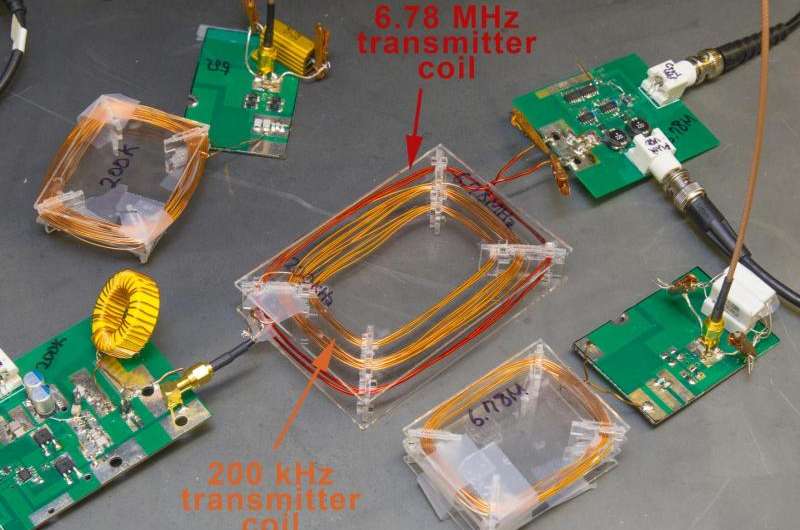With this new universal wireless charger, compatibility won't be an issue

A wireless charger that's compatible with different consumer electronics from different brands is one step closer to becoming a reality thanks to research by electrical engineers at the University of California, San Diego.
Researchers have developed a dual frequency wireless charging platform that could be used to charge multiple devices, such as smartphones, smartwatches, laptops and tablets, at the same time—regardless of which wireless standard, or frequency, each device supports.
"To our knowledge, this is the only multi-standard wireless power transmitter that's been shown to operate simultaneously at two different frequencies with high efficiency," said Patrick Mercier, a professor in the Department of Electrical and Computer Engineering at UC San Diego who led the study published in the journal IEEE Transactions on Power Electronics.
The new proof of concept study not only presents a "universal wireless charger" that can deliver power to multiple devices concurrently, it addresses an issue that afflicts existing wireless technology: incompatibility between the three competing wireless standards in today's market (known as Qi, Powermat and Rezence). Each wireless charger so far supports either the Qi, Powermat, or Rezence standard and will only work with devices that support the same standard.
As a result, wireless charging technology is ripe for a battle similar to the one that took place between Blu-ray and HD DVD. A battle between incompatible wireless standards could cripple the field until a winner emerges.
"To help avoid such a situation, we developed a wireless technology that is universal and supports all of these standards so it won't matter which standard your device supports," said Mercier, who is affiliated with the Center for Wireless Communications and is the co-director of the Center for Wearable Sensors, both at UC San Diego.
These three standards operate under different frequencies: Qi and Powermat operate at around 200 kHz while Rezence operates at 6.78 MHz. So herein lies the challenge. In order for a single charging device to support multiple standards, it needs to operate across these very different frequencies.
A wireless charger's ability to operate at a particular frequency depends on its transmitter coil. Wireless charging generally requires the charger's transmitter coil to send a high-power signal out to a compatible receiver coil in the device-to-be-charged. Existing wireless chargers are typically built with a transmitter coil that's optimized to work at one frequency. But as a consequence, the chargers are extremely inefficient at other frequencies.
To address this problem, Mercier and his team built a charging platform capable of simultaneously operating across the frequencies supported by all three wireless power standards. The prototype that they built is a thin, rectangular box (12.5 centimeters × 8.9 centimeters) that contains two transmitter coils: an inner coil optimized to operate at a frequency of 200 kHz, and an outer coil optimized to operate at 6.78 MHz. One of the features of this design is that the coils lie in the same plane, allowing for a compact size. The platform is just big enough to fit two smartphones side by side. Another important feature of the prototype is a filtering circuit that the researchers designed to prevent the coils from interacting with each other and causing efficiency losses.
The researchers then tested the charging platform using two receiver coils (one optimized for 200 kHz operation and the other for 6.78 MHz), which served as models for two different smartphones. Engineers demonstrated that the charging platform was able to deliver power to both receiver coils at the same time at efficiencies ranging from 70 to 80 percent. The receiver coils were also able to receive power regardless of where they were placed on the charging platform.
"This means that multi-device and multi-standard wireless charging don't have to come at a significant efficiency penalty," said Mercier.
The researchers have filed patents on this technology and are looking for commercial partners to help bring the universal wireless charger into the market.
More information: "Wireless Power Transfer with Concurrent 200 kHz and 6.78 MHz operation in a Single Transmitter Device," by Dukju Ahn and Patrick P. Mercier. The paper was published online Sept. 18, 2015 in the journal IEEE Transactions on Power Electronics. ieeexplore.ieee.org/stamp/stam … tp=&arnumber=7272106
Provided by University of California - San Diego





















